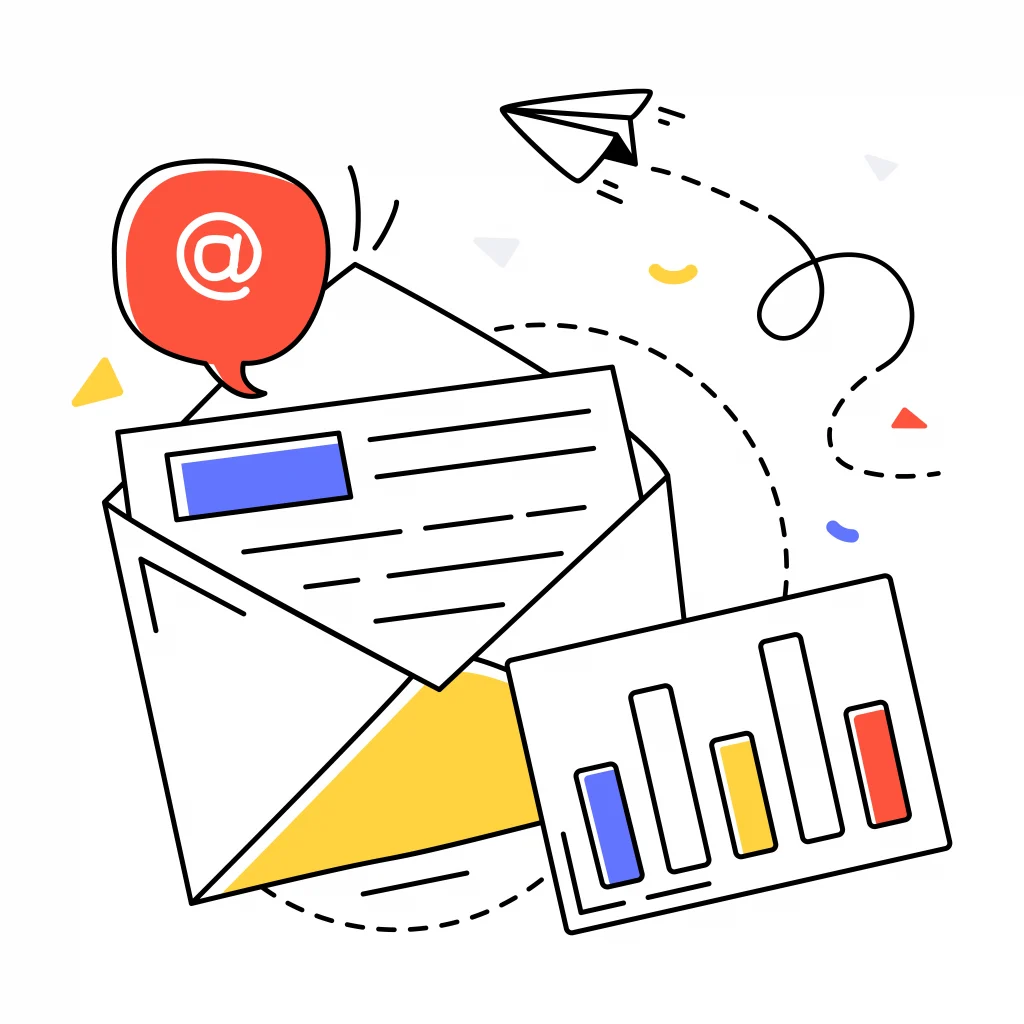In the ever-evolving realm of digital communication, email remains a critical tool for businesses and individuals alike. However, standing out in the vast sea of an inbox requires more than just compelling content. A whopping 47% of email recipients admit they decide to open an email based solely on its subject line. As digital marketing pioneer Ann Handley aptly states, “Your subject line is your first (and maybe your last) impression on users.” Dive deeper with us into the nuanced world of crafting magnetic subject lines that not only captivate but convert.

Understand Your Audience
Knowing your audience reigns supreme. Every individual, group, or demographic comes with its unique set of interests, desires, and triggers. Imagine trying to serenade a jazz lover with heavy metal—it’s not going to resonate. Similarly, compelling email subject lines are the melodies that play perfectly to the preferences of their intended audience.
A sweeping, generalized approach often falls flat. Instead, delving deep into your audience’s characteristics is essential. Whether you’re sifting through demographics, analyzing past purchase patterns, or decoding behavioral data, this understanding lays the groundwork for crafting subject lines that hit home.
By ensuring your subject lines align with your audience’s preferences, you’re not just shooting in the dark; you’re aiming with precision, elevating the chances of eliciting genuine interest and engagement.
Keep it Short and Sweet
Users often skim through their inboxes, making quick decisions. Herein lies the power of brevity. When a message is succinct, it stands a better chance of capturing fleeting attention. With the rise of mobile browsing, this becomes even more crucial. Picture this: you’re on the move, quickly scanning your emails on your phone. You’re more likely to click on an email with a concise and punchy subject over one that’s long-winded and overwhelming.
Compelling email subject lines should be concise gems that convey the crux in limited characters. Given that most mobile interfaces comfortably display between 40-50 characters, your challenge lies in fitting your message snugly within this space. A subject line such as “50% Off Summer Styles Today!” is both short and enticing, whereas “Our New Summer Collection is Now Available at Half the Price for Today Only!” is a mouthful that might get truncated, losing its appeal.
Use Action-Oriented Verbs
Picture a powerful movie trailer. What grabs your attention? It’s those dynamic verbs that compel action—’Fight,’ ‘Chase,’ ‘Discover.’ Similarly, in the universe of compelling email subject lines, action verbs act as catalysts, driving users to click and read further. They’re the pulse, infusing life and energy into an otherwise static line.
Starting your subject line with vibrant verbs like “Unearth,” “Snatch,” or “Plunge into” isn’t just about sounding cool. It’s a strategic move, nudging the reader’s subconscious into thinking there’s something worthwhile awaiting inside. Let’s consider the difference: “New Shoe Collection Released” versus “Stride into Our Latest Shoe Collection!” The latter not only calls for action but paints a vivid mental image.
The right verb can transform a passive reader into an active participant. So, when drafting your next email subject, think of it as an invitation to a dance.
Pose a Question or Challenge
Ever been in a conversation when someone asked a question that made you stop and think? There’s an undeniable allure to such queries—they beckon us to engage, reflect, and often respond. Within the scope of compelling email subject lines, this tactic can work wonders. Questions and challenges can serve as powerful anchors, reeling in your readers from the vast ocean of their overflowing inboxes.
Take a subject like “Looking for the Perfect Summer Outfit?” for a fashion brand. It not only addresses a potential need but also invites the recipient to explore solutions within the email. Similarly, for a tech company, a challenging line like “Think You Know the Latest Tech Trends?” can prompt a click from a curious reader, eager to test their knowledge.
In crafting these compelling email subject lines, the aim is to transform a simple inquiry or challenge into a doorway. A doorway that invites the reader into a realm of solutions, discoveries, or opportunities. So, next time you’re penning down a subject line, ask yourself: “What question would make my readers’ eyebrows raise in intrigue?”
Avoid Clickbait Tactics
In the vast digital arena, it’s tempting to stand out with glittering promises or sensational statements. However, just as a castle built on sand crumbles, using clickbait in compelling email subject lines can erode your audience’s trust. Sure, a headline screaming “You Won’t Believe This!” might attract initial clicks, but what follows matters even more.
Let’s consider a brand offering a revolutionary skincare product. A clickbait subject might read, “Erase All Your Wrinkles Overnight!” But if the product merely reduces the appearance of fine lines over time, the disparity between promise and delivery becomes clear. Subsequently, the recipient feels duped, leading to potential unsubscriptions or, worse, negative word of mouth.
Instead, transparent and genuine communication paves the way for a lasting relationship. A more honest subject line like “Discover Our New Anti-Aging Formula!” aligns expectations with reality, ensuring a satisfied and informed reader.
Transitioning from clickbait to authentic communication doesn’t mean sacrificing engagement. On the contrary, when readers know they can trust your words, they’re more likely to eagerly await your emails.
Personalize Where Relevant
Imagine walking into a cafe where the barista, without prompting, starts preparing your favorite drink. It’s a small gesture, but the impact is profound. Such tailored experiences create a bond, and this principle holds true in crafting compelling email subject lines. Rather than sending generic messages that get lost in the noise, personalized emails feel like a hand-written letter in a world of printed memos.
For instance, if you’re a book retailer, instead of a generic “Check Out Our New Arrivals!” you could personalize with, “Jane, Thought You’d Love These Mystery Novels!” By doing so, not only have you acknowledged Jane’s preferences, but you’ve also made her feel valued.
In essence, personalization isn’t just about addressing your recipient by name—it’s about echoing their preferences, history, and aspirations. By integrating these nuances, your emails cease to be just another notification; they become anticipated interactions. So, when weaving your next compelling email subject lines, think of each recipient as a unique individual, not just a name on a list.
Test Emojis and Symbols Carefully
Emojis, once the sole domain of casual chats, have evolved into powerful tools in modern communication. When used effectively in compelling email subject lines, they can instantly convey emotion or urgency, acting as a visual magnet. For instance, a travel agency might use the airplane ✈️ emoji to highlight vacation deals, turning a plain “Exclusive Vacation Deals!” into a more enticing “✈️ Jet Off With Our Exclusive Vacation Deals!”
Yet, it’s essential to tread with caution. Just as a misplaced ingredient can alter a dish’s taste, an ill-chosen emoji can distort your message’s intent. Moreover, not all emojis are universally recognized. What looks like a cheerful gesture on one device could morph into a meaningless box on another.
Therefore, before integrating emojis, it’s prudent to test them on various platforms. Websites such as Emojipedia can give insights into an emoji’s appearance across different devices. Beyond ensuring visual consistency, this step helps maintain the tone and intention behind your message.
Use A/B Testing
In the arena of email marketing, making data-driven decisions is paramount. While intuition can sometimes point you in the right direction, A/B testing acts as the compass that ensures you’re not veering off course. Think of it as a digital duel, where two compelling email subject lines go head-to-head, and your audience determines the champion.
For instance, if you’re launching a new health supplement, you might be torn between emphasizing its natural ingredients with “Harness Nature’s Best for Your Health!” or its scientific backing with “Clinically-Proven Health Boost!” Through A/B testing, you can send both versions to different segments of your audience and let their interactions dictate the winner.
Transitioning from assumptions to actionable insights, A/B testing reveals patterns in preferences, which can guide not only your future subject lines but also other facets of your content. Moreover, periodic A/B tests can keep your strategies updated, given that audience behavior is never static.
Stay Updated with Trends and Seasons
The ability to timely adapt gives brands a distinctive edge. By aligning your compelling email subject lines with current events, seasons, or prevailing sentiments, you immediately position your content in the spotlight of relevance. Picture this: as summer approaches, a line like “Sizzle with Our Summer Collection!” not only evokes the warmth of the season but also piques curiosity about the new offerings.
Nevertheless, while it’s tempting to hop on the trend-wagon, it’s essential to sprinkle your own unique flavor. For example, when winter festivities start rolling in, instead of the often overused “Winter Wonderland Deals!”, you might opt for a more distinctive “Unwrap Winter’s Coziest Secrets with Us!”
Furthermore, monitoring trending hashtags, news headlines, or pop culture moments can provide inspiration for timely and engaging subject lines. However, always ensure that the trend aligns with your brand’s voice and values. Misalignment can appear as forced or inauthentic.
Monitor and Adjust
In the dynamic digital realm, complacency can quickly overshadow success. Compelling email subject lines that performed exceptionally well last month might not achieve the same results today. Why? Consumer behaviors, platform algorithms, and even global events play pivotal roles in the changing email landscape.
For instance, let’s consider open rates. A surge might indicate that your latest subject line formula resonates with your audience. Conversely, a decline could signal that it’s time to rethink and innovate. Similarly, higher click-through rates can reflect the effectiveness of your call-to-action, while increased unsubscribe rates could wave a red flag about content relevance or frequency.
However, it’s not just about data, but the stories they tell. Beyond mere numbers, delve into feedback loops, customer reviews, and even direct conversations with your subscribers. These insights, often overlooked, provide rich context to quantitative metrics, painting a holistic picture of your email strategy’s impact.
Transitioning from insights to action, regularly revisit and tweak your approaches. Perhaps it’s time to introduce a fresh tone, or maybe an emoji that captures the current sentiment. In essence, the journey to perfecting compelling email subject lines is iterative, fueled by both creativity and analytics.

Crafting compelling email subject lines is akin to striking gold in the vast mine of digital communication. It’s not just about clever wording or catchy phrases but understanding the profound psychology of the reader. Remember, behind every click is a person seeking value, relevance, or a spark of curiosity.
By continuously refining, testing, and learning, marketers can master this pivotal skill. It’s an ongoing dance—a synergy between creativity and data-driven insights. So, as we advance in this digital age, let us harness the power of compelling email subject lines, turning mere opens into meaningful connections and lasting brand stories.
Andjela Zdravkovic
Social Media Manager at Vuk Multimedia since 2023